-
Car Reviews
- All reviews
- Midsize SUVs
- Small cars
- Utes
- Small SUVs
- Large SUVs
- Large cars
- Sports SUVs
- Sports cars
- Vans
Latest reviews
- Car News
-
Car Comparisons
Latest comparisons
- Chasing Deals
- ChasingCarsGPT
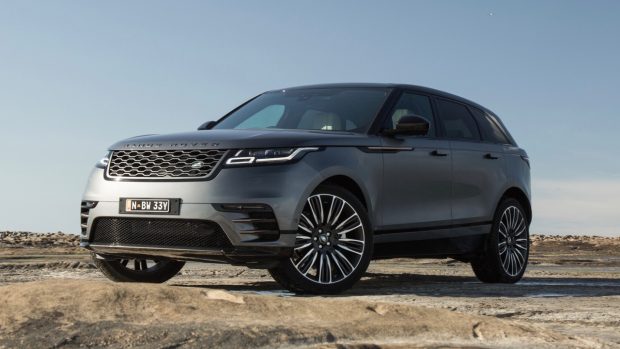
The boom in SUVS – and luxury SUVs, in particular – has been great for Land Rover. Britain’s original four-wheel-drive specialist is flush with credibility and that badge is highly desirable – so as the market for high-riders has grown and grown, Land Rover’s biggest problem is having enough products to offer. Everybody wants some underlying layer of off-roading ability, the brand says, but the rest is all negotiable: big, small, in-between; fast, or economical; comfortable, or sporty. And until recently, the brand’s five-pronged range, split into two (slightly) more utilitarian Land Rover-badged vehicles, and three aspirational Range Rovers, has been adequate.
However, the big demand now is for premium mid-size SUVs – and oddly, there hasn’t really been one on Land Rover showroom floors. The Range Rover Evoque is town-sized; the new Land Rover Discovery, and the venerable Range Rover Sport, are both on the large side – and in the case of the Sport, competition from Porsche makes that car look a little out of vogue, design-wise. Hence the business case for a new Range Rover model line – the 2018 Range Rover Velar. Medium-sized, packing plenty of visual flair and spanning broad price points from $71,000 to $169,000, the Velar finds clear targets in the Macan, GLC, and X5 set.
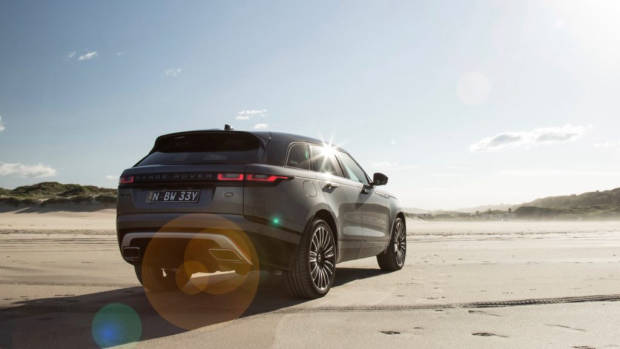
Haven’t heard of Velar? You’d be forgiven: this is a name seen in the Land Rover history books before, though only brand anoraks would remember it. In the mid-sixties, the brand were out to design a more comfortable version of their Series II farm wagon – a vehicle that would eventually become the first-generation Range Rover. Early prototypes, in an effort to disguise the true new badge, wore the codename ‘Velar’ on their bonnets. Fast forward forty-eight years, though, and the second use of the Velar name is far from a prototype. Instead, this finished product hits a number of early high notes, which start when you approach the car. The size is about right, on the long side of medium. The looks capture attention, with a wide range of colour, wheel, roof and appearance package options available. The Velar has clear Range Rover DNA, but the implementation is up to the minute, with striking light assemblies, vanishing door handles, appropriately upsize wheels, and attractive use of gloss black to highlight aggressive elements on the face and side profile. Side-by-side, the Velar makes the Sport – itself a handsome vehicle – look, well, old.
Aspirational, then? Sure, from the outside – and the Velar’s sensory assault continues once you’ve pulled the chunky handles – which are accessible when the vehicle is stopped and unlocked, before tucking away into the bodywork. Inside, the Velar debuts Land Rover’s new cabin concept. There are cues from the Range Rover Sport in here, but with major updates that include a focus around a dual stacked touchscreen arrangement in the centre console. Super-crisp and intuitive, the twin screens are standard and mark out technology as a Velar strong suit – the Porsche Macan and Mercedes GLC cabins look, by contrast, basic. A further 12-inch widescreen can be optioned ahead of the driver, providing a large map in line-of-sight, or an impression of traditional gauges.
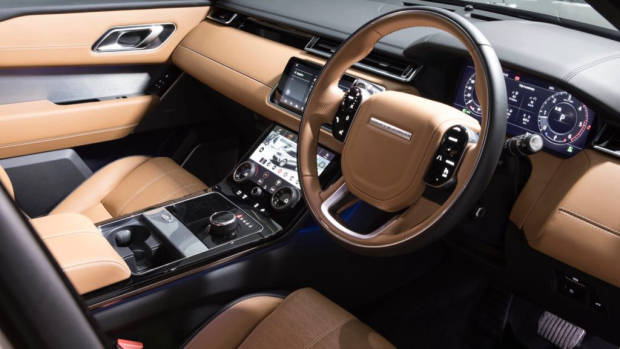
Customisation is encouraged, with the contemporary cabin providing a blank canvas for a broad choice of upholstery colours and material choices. It isn’t cheap, but you’ll benefit from stepping up to high-grade Windsor leather, which makes the Velar’s hides soft enough to wear the Range Rover badge. This leather is available in six colours, including a fetching tan and black two-tone. For the first time in a Land Rover, a premium non-leather textile fabric is available for the seats, commanding a $2,500 premium. Though it’s (implicitly) targeted at those who want a luxury material that avoids animal products, the textile – produced by Danish designer Kvadrat – looks and feels special enough to serve as a leather substitute. We like quality fabric seats, and the choice of a high-end textile is refreshing in a luxury car for those that don’t want or appreciate leather – for one thing, leather becomes very hot in the Australian summer. The fact the Kvadrat textile can be combined with the twenty-way adjustable seat, is a plus.
Though the Velar is clearly related by looks to its Range Rover Sport sibling, under the skin, it has far more in common with the Jaguar F-Pace. Like that sporty SUV produced by Land Rover’s cousin, the Velar sits on the rear-wheel-drive iQ-Al platform that also underpins the great-to-drive Jaguar XE and Jaguar XF. iQ-Al allows for all-wheel-drive, and every Velar has that feature (unlike the F-Pace, which is available in either all- or rear-wheel-drive). However, the chassis’ on-road origins does little to stop it off road: the Velar is faithful to the Land Rover badge. We drove a set of appropriately-optioned Velars pretty far off-road through the Hunter Valley, and they impressed – largely thanks to the air suspension, fitted as standard to V6 models, that can raise the body to 251mm, enough to wade a depth of 650mm. However, a locking rear differential ($1,100), and a pack that bundles the Terrain Response 2 off-roading computer with sophisticated off-road cruise control ($1,700), remain on the options list. Check those boxes, and the Velar will get you much further than a fashion-forward medium SUV needs to.
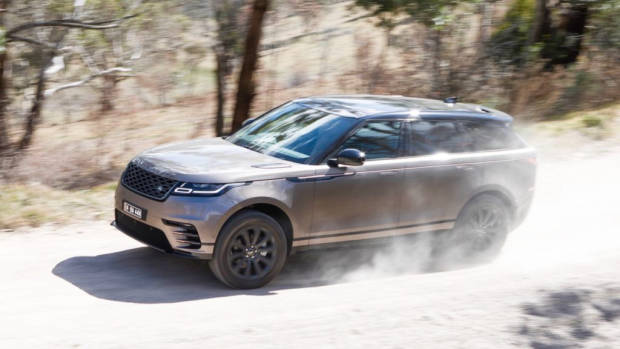
A substantial part of the appeal of a Range Rover over a Porsche, a Mercedes-Benz, a BMW, or an Audi, is the rugged chic indelibly linked to Land Rover’s green badge – so establishing some cred for the otherwise urban-focussed Velar was considered critical. However, there’s little doubt that most of these vehicles will spent their lives on tarmac. It’s on the road that the Velar strongly differentiates itself from both the F-Pace and the Range Rover Sport. Of the three, the Velar is the best to drive, and fits the premium SUV brief best. The first few corners demonstrate that the Velar makes no attempt to follow the F-Pace into sporty SUV territory, and that’s fine. In a move befitting of the Range Rover marque, air-suspension equipped Velars ride beautifully. Buy a V6 – which packs the air suspension – or option it for $2,110 on a four-cylinder model, and you have one of the most comfortable SUVs on the road. Amazingly, the supple ride doesn’t fall apart at all on the absurdly large 21-inch or 22-inch wheels that are fitted to high-spec grades. In the F-Pace, opting for 20-inch wheels or above with that car’s steel suspension sees the ride quality deteriorate humiliatingly to bone-shaking brittleness. The standard coil springs on four-cylinder Velars fall somewhere in the middle. We would not be skipping the air suspension.
While it rides beautifully, the Velar handles acceptably. And that is fine: this is a lush luxury SUV. If you want a sports car, buy a Jaguar F-Type. The Range Rover Velar takes corners best when not pushing it too hard. The moderate body roll is hardly exaggerated, but this car just calls for a nice-and-easy approach. The light tiller doesn’t have much in the way of feel or feedback, but the Velar rotates satisfyingly. Move from relaxed territory into the frenetic zone and you can feel the great iQ-Al chassis underneath, but there’s none of the F-Pace’s oversteer characteristics; instead, the Velar’s front-end ploughs into predictable understeer as the two-tonne mass overpowers the tyres. It can tango, it just doesn’t really want to be be treated in that sort of undignified manner. Jaguar-Land Rover will sell you cars for sporting purposes, but the Velar’s mission in life is to cruise, comfortably.
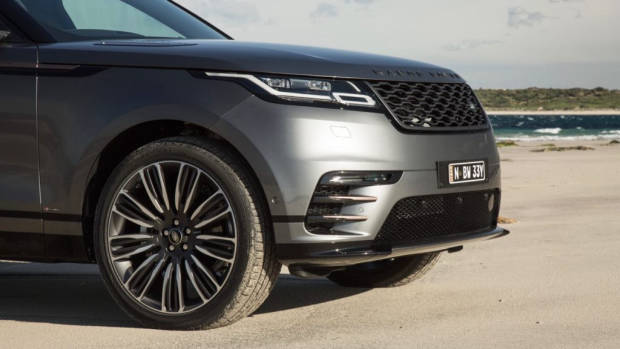
And cruise it does, provided you are a little discerning with what you put under the long bonnet. The Velar joins the Evoque in being designed primarily around four-cylinder engines, but if you can stretch to them, either six-cylinder is an inspired choice. The petrol P380 takes the 250kW/450Nm V6 from the Jaguar F-Type coupe; this gutsy powerplant, full of supercharger whine, makes the Velar properly fast, achieving a rapid 5.7 second 0-100km/h sprint, the front end rising comically with a shove of the loud pedal. The P380 is pretty thirsty, but it’s very refined and will satisfy those who want the Velar to be as fast as it looks. But our choice would be the D300 – the diesel V6, which uses Jaguar-Land Rover’s awesome 221kW/700Nm twin-turbo to great effect. It’s still quick – the diesel is only 0.8 seconds behind the P380 to 100km/h – but in reality, that huge shove of torque makes it more usefully fast, more of the time. The engine is barely audible, although at high revs, the D300 sounds menacing. And it’s impressively frugal, returning under 10L/100km.
Although you can pair any of the Velar’s six engines to any trim grade – a novel offering in a segment that usually ties faster engines to a more equipment, and thus a high price – it’s the four-cylinder Velar options that will attract many new buyers to Land Rover showrooms. Of these, the D240 twin-turbo diesel is our main recommendation. Producing 177kW/500Nm, it lacks the six-cylinder’s ultimate refinement but it offers good grunt and very solid fuel economy. We would avoid the slow 132kW D180; the 221kW P300 is gutsy, although a petrol turbo four isn’t the first type of engine that comes to mind for a vehicle of this size. That the six-cylinders also bundle the air suspension that we think is critical to the experience offers a compelling reason to cut back on equipment options in favour of a bigger engine – but the Velar lineup offers so much choice that buyers will need to think about their priorities. Do you want a more refined engine, or more luxury inside? If you want both, the costs can get out of control, with fully-loaded examples breaking the $170,000 mark.
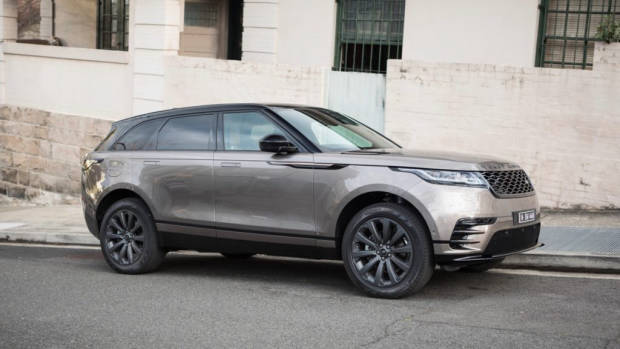
To help you start the process of wading through the confusing array of Velars on offer – the first choice is the (dowdy) standard Velar or the (cool-looking) Velar R-Dynamic – we’d choose the latter. From there, it’s a choice of base, S, SE, HSE, or First Edition trims. Making this choice will depend on budget. If you’re thinking around the $100,000 mark, a D240 R-Dynamic S ($98,050) is a good place to start, though you will need to think about optioning air suspension ($2,110), 21-inch wheels to fill the guards (from $2,450), and heated and memory front seats ($850).
If you can splurge, our ‘keep it simple’ recommendation is the D300 R-Dynamic HSE ($135,150), which has most desirable features fitted as standard, including attractive 21-inch wheels, the far more comfortable 20-way electric seats, with high-grade Windsor leather, plus the suite of adaptive safety technologies that ought to be standard across the range – but aren’t.
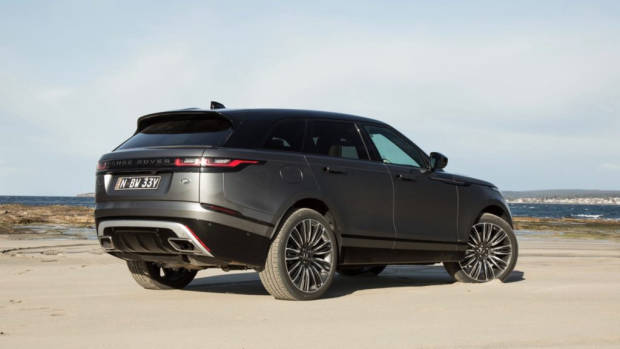
While standard equipment is actually pretty good – all cars receive the impressive InControl Touch Pro dual-screen infotainment, AEB and lane departure warning, and most have premium Meridian audio, leather, and an electric tailgate as standard, like all Jaguar-Land Rover products, the Velar’s options list opens up further extensive customisation. Costs can really escalate here, but these are nice-to-haves rather than must-haves: an opening panoramic sunroof is $4,370; luxe suedecloth headlining $2,630; four-zone climate control $1,910; a more useful heads-up display is way too expensive at $2,420. However, you don’t need to touch the options list to get a Velar that is satisfyingly-trimmed (as long as it’s a V6 – which has air suspension as standard. You’re probably getting that we think air suspension is worthwhile).
It’s hard to see how the Range Rover Velar won’t make a popular addition to the British brand’s lineup. The Velar covers the essential five-seat, mid-size space, giving Land Rover a critical competitor to aspirational SUVs like the Porsche Macan, as well as the Mercedes GLC/GLE and BMW X4/X6 siblings. And it arrives in the luxury mid-size space in style, with expensive looks, a lush interior, a superior cabin technology proposition, and broad options for buyer customisation. A field of impressive engines and decent-enough standard equipment mean that there are few intellectual obstacles to considering one. Just make sure you choose the engine and grade that gives you what you need while keeping the cost in check, and we think a Velar will do the job nicely.
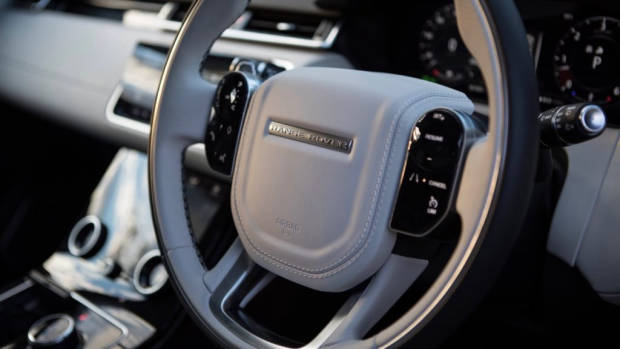
Key specs (as tested)
About Chasing cars
Chasing Cars reviews are 100% independent.
Because we are powered by Budget Direct Insurance, we don’t receive advertising or sales revenue from car manufacturers.
We’re truly independent – giving you Australia’s best car reviews.
The estimate provided does not take into account your personal circumstances but is intended to give a general indication of the cost of insurance, in order to obtain a complete quote, please visit www.budgetdirect.com.au. Estimate includes 15%^ online discount.
^Conditions Apply
Budget Direct Insurance arranged by Auto & General Services Pty Ltd ACN 003 617 909(AGS) AFSL 241 411, for and on behalf of the insurer, Auto & General Insurance Company Limited(ABN 42 111 586 353, AFSL 285 571).Because we don’t know your financial needs, we can’t advise you if this insurance will suit you. You should consider your needs and the Product Disclosure Statement before making a decision to buy insurance. Terms and conditions apply.
Indicative quote based on assumptions including postcode , 40 year old male with no offences, licence suspensions or claims in the last 5 years, a NCD Rating 1 and no younger drivers listed. White car, driven up to 10,000kms a year, unfinanced, with no modifications, factory options and/or non-standard accessories, private use only and garaged at night.
^Online Discounts Terms & Conditions
1. Discounts apply to the premium paid for a new Budget Direct Gold Comprehensive Car Insurance, Third Party Property Only or Third Party Property, Fire & Theft Insurance policy initiated online on or after 29 March 2017. Discounts do not apply to optional Roadside Assistance.
2. Discounts do not apply to any renewal offer of insurance.
3. Discounts only apply to the insurance portion of the premium. Discounts are applied before government charges, taxes, levies and fees, including instalment processing fees (as applicable). The full extent of discounts may therefore be impacted.
4. We reserve the right to change the offer without notice.